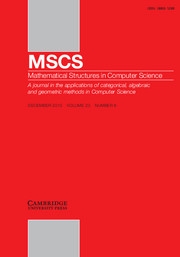No CrossRef data available.
Article contents
Complexity of inversion of functions on the reals
Published online by Cambridge University Press: 27 October 2025
Abstract
We study the complexity of deterministic and probabilistic inversions of partial computable functions on the reals.
Information
- Type
- Paper
- Information
- Copyright
- © The Author(s), 2025. Published by Cambridge University Press
Footnotes
†
Authors are in alphabetical order. Thanks to Liang Yu for corrections and suggestions. Supported by Beijing Natural Science Foundation (IS24013)
References
Avigad, J. and Brattka, V. (2014). Computability and Analysis: The Legacy of Alan Turing. In: Lecture Notes in Logic, Cambridge University Press, 1–47.Google Scholar
Barmpalias, G., Day, A. R. and Lewis-Pye, A. E. M. (2014). The typical Turing degree. Proceedings of the London Mathematical Society 109 (1) 1–39.10.1112/plms/pdt065CrossRefGoogle Scholar
Barmpalias, G. and Zhang, X. (2025). Computable one-way functions on the reals. Information and Computation 306.10.1016/j.ic.2025.105327CrossRefGoogle Scholar
Bienvenu, L. and Patey, L. (2017). Diagonally non-computable functions and fireworks. Information and Computation 253 64–77.10.1016/j.ic.2016.12.008CrossRefGoogle Scholar
Blum, L., Shub, M. and Smale, S. (1989). On a theory of computation and complexity over the real numbers:
 $NP$
- completeness, recursive functions and universal machines. Bulletin of the American Mathematical Society 21 (1) 1–46.10.1090/S0273-0979-1989-15750-9CrossRefGoogle Scholar
$NP$
- completeness, recursive functions and universal machines. Bulletin of the American Mathematical Society 21 (1) 1–46.10.1090/S0273-0979-1989-15750-9CrossRefGoogle Scholar
Brattka, V. (2016) Computability and analysis, a historical approach. In: Beckmann, A., Bienvenu, L. and Jonoska, N. (eds.) Pursuit of the Universal, Cham: Springer International Publishing, 45–57.10.1007/978-3-319-40189-8_5CrossRefGoogle Scholar
Chong, C. T. and Yu, L. (2015). Recursion Theory: Computational Aspects of Definability, Vol. 8. Walter de Gruyter GmbH & Co KG.10.1515/9783110275643CrossRefGoogle Scholar
Downey, R. G. and Hirschfeldt, D. (2010). Algorithmic Randomness and Complexity, Springer.10.1007/978-0-387-68441-3CrossRefGoogle Scholar
Friedberg, R. M. (1958). 4-quantifier completeness: A Banach-Mazur functional not uniformly partial recursive. Bulletin de l’Académie Polonaise des Sciences, Série des Sciences Mathématiques, Astronomiques et Physiques 6 1–5.Google Scholar
Fu, M. Q. and Zucker, J. (2015). Models of computation for partial functions on the reals. Journal of Logical and Algebraic Methods in Programming 84 (2) 218–237.10.1016/j.jlamp.2014.11.001CrossRefGoogle Scholar
Gács, P. (2024). A (partially) computable map over infinite sequences can be one-way. Circulated Draft. Circulated draft, May 8.Google Scholar
Grzegorczyk, A. (1955). Computable functionals. Fundamenta Mathematicae 42 (1) 168–202.10.4064/fm-42-1-168-202CrossRefGoogle Scholar
Hoyrup, M. (2014). Irreversible computable functions. In: Mayr, E. W. and Portier, N. (eds.) 31st International Symposium on Theoretical Aspects of Computer Science (STACS 2014), STACS 2014, March 5-8, 2014, Lyon, France, Vol. 25 of LIPIcs, Schloss Dagstuhl - Leibniz-Zentrum für Informatik, 362–373.Google Scholar
Hoyrup, M. and Gomaa, W. (2017). On the extension of computable real functions. In: 32nd Annu. ACM/IEEE Symp. Logic Comput. Sci. (LICS), IEEE Press, 1–12.10.1109/LICS.2017.8005067CrossRefGoogle Scholar
Ko, K.-I. (1991). Complexity theory of real functions, Birkhäuser Boston Inc., USA., Birkhäuser.10.1007/978-1-4684-6802-1CrossRefGoogle Scholar
Kurtz, S. (1981). Randomness and genericity in the degrees of unsolvability. PhD Dissertation, Urbana, University of Illinois.Google Scholar
Levin, L. A. (2003). The tale of one-way functions. Problems of Information Transmission 39 (1) 92–103.10.1023/A:1023634616182CrossRefGoogle Scholar
Levin, L. (2023). Email correspondence, December 2023. with G. Barmpalias, and P. Gács, A. Lewis-Pye, A. Shen.Google Scholar
Martin, D. (1967). Measure, category, and degrees of unsolvability. Unpublished manuscript.Google Scholar
Martin-Löf, P. (1966). The definition of random sequences. Information and Computation 9 602–619.Google Scholar
Miller, J. S. and Yu, L. (2008). On initial segment complexity and degrees of randomness. Transactions of the American Mathematical Society 360 (6) 3193–3210.10.1090/S0002-9947-08-04395-XCrossRefGoogle Scholar
Paris, J. (1977). Measure and minimal degrees. Annals of Mathematical Logic 11 (2) 203–216.10.1016/0003-4843(77)90018-3CrossRefGoogle Scholar
Pour-El, M. B. and Richards, J. I. (1989). Computability in analysis and physics. In: Perspect. Math. Log, Berlin, Springer.Google Scholar
Stephan, F. (2006). Martin-Löf random and PA-complete sets. In: Logic Colloquium ’02, Vol. 27 of Lect. Notes Log., La Jolla, CA, Assoc. Symbol. Logic, 342–348.Google Scholar
Turing, A. M. (1936). On computable numbers with an application to the Entscheidungsproblem. Proceedings of the London Mathematical Society 42 (3) 230–265, A correction, 43:544-546.Google Scholar
van Lambalgen, M. (1990). The axiomatization of randomness. Journal of Symbolic Logic 55 (3) 1143–1167.10.2307/2274480CrossRefGoogle Scholar
Weihrauch, K. (1993). Computability on computable metric spaces. Theoretical Computer Science 113 (2) 191–210.10.1016/0304-3975(93)90001-ACrossRefGoogle Scholar
Weihrauch, K. (2013). Computable Analysis: An Introduction, Springer Publishing Company, Incorporated.Google Scholar


